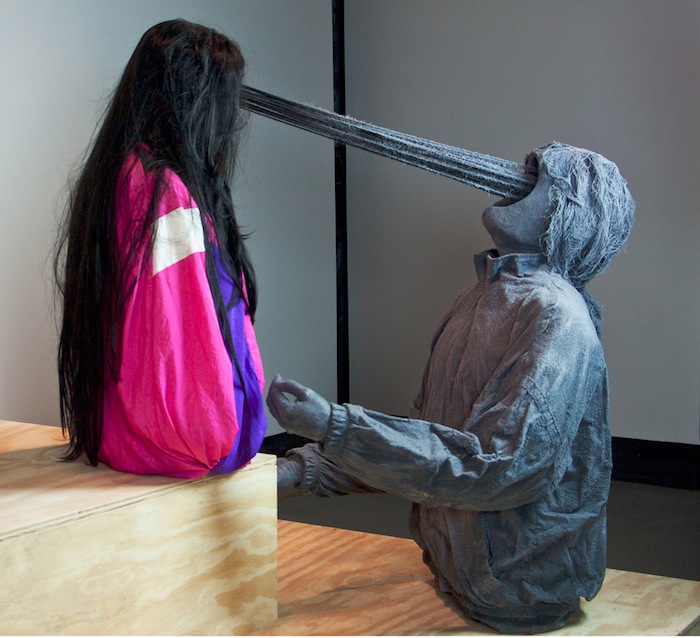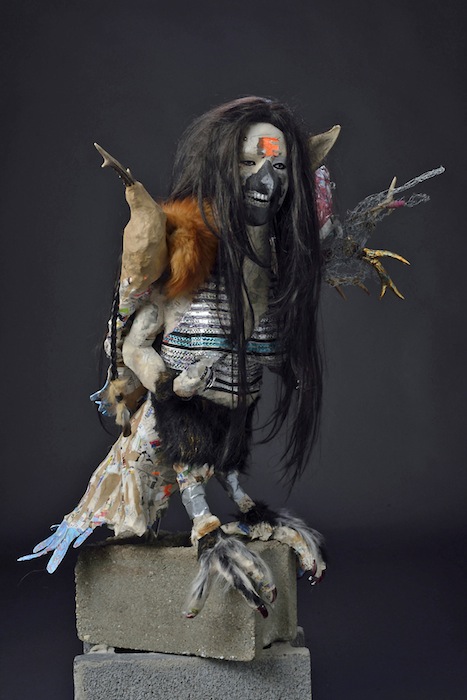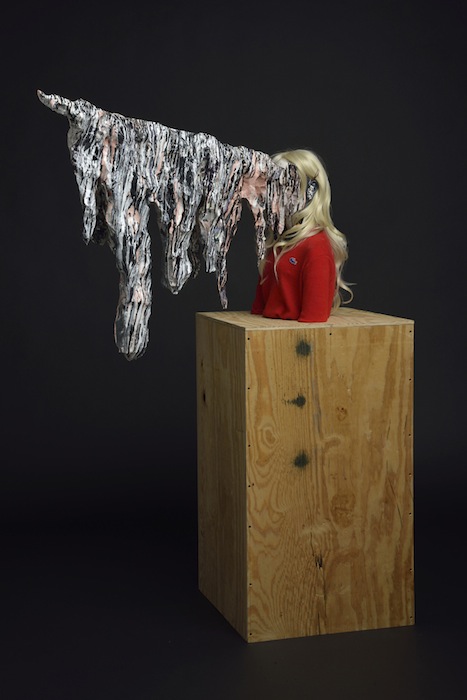
Roxanne Jackson , Title: Don’t Stop Believin’, 2013
Media: Track jackets, ceramic, wigs, flocking, yarn, cast plaster hands
Dimensions: 4 x 3 x 2 feet
Roxanne Jackson’s exhibition Death Valley was on view this past autumn at AIRPLANE Gallery in Bushwick, Brooklyn. The show featured a selection of mythical sculptures by the artist and was on view from October 11 – November 16, 2013. Here ETTD contributor Sarah Walko, gives her take on the exhibition, the artists’ work and the historical relationship that we have with the fantastical.

Roxanne Jackson , Title: Steal Your Face, 2013
Media: Ceramic, glaze, ceramic decals, wig, platinum silver luster
Dimensions: 18 x 22 x 13 inches
Jackson’s sculptural installation in the gallery was composed of a cast of pop culture/horror characters and the installation was similar to what one might find at a wax museum. There were three tiers of platforms ascending the wall creating the effect of making one as a viewer feel as though he or she is on stage and the characters and all of their strange parts are the audience, an all encompassing universe they are involved in. It also called my attention to their relationships to each other, linking their stories, bringing to mind the weird third panel in Hieronymus Bosch’s The Garden of Earthly Delights and Munch’s dark and surreal The Scream. Her characters and objects however are not just one-off weird or nightmarish things, they are playful talismans creating transformational and humorous dialogue between culturally accepted ideas of what is beautiful and what is beastly, what is banal and what is sublime. Her varied subjects compliment her varied mediums, from papermaché to hair to refined glazed ceramics, striping a hierarchy of preciousness as they all integrate together creating a discordant tone. This use of materials also conceptually strengthens her critique of the glorification of popular culture as universal mythology.

Roxanne Jackson , Title: Harpy, 2013
Media: Papier-Mache, chicken wire, wig, antlers, iridescent gold leaf, cinder block, faux and real
fur, resin, cast aluminum teeth, taxidermy deer ear, crystals, metallic paper, press-on nails and
nail polish
Dimensions: 3 x 5 x 2 feet
Jackson’s work also calls to mind the infamous Medusa in Greek Mythology, the guardian protectress monster, usually illustrated with the face of a terrifying human female, venomous snakes replacing her long locks of hair. There are many ceramic snakes wrapped around differing character parts in the exhibition, adding to this tone of old lore and dark magic. If myths are considered truthful depictions, exaggerated or over-elaborated accounts of historical events, natural phenomena depicted as allegory or personification, then Jackson’s mythos felt like an accurate imaginative manifestation containing many aspects of our current times personified. Each character or object has a history and the tone of the gallery seemed to be holding a sacred narrative.
There are four basic functions of mythology: metaphysical/mystical, cosmological, sociological, and pedagogical. The metaphysical/mystical function is to awaken us to mystery and wonder, our mystical “ground of being”. The cosmological function of mythology is to describe the shape of the cosmos, its vastness and our total integration within it. Its sociological function is to pass down moral and ethical codes for people of that culture to follow, and which help define that culture and its prevailing social structure. The pedagogical function is to lead us through particular rites of passage and rituals, defining significant stages of our lives-from dependency to maturity to old age, and finally, to our death. Rites of passage bring us back into harmony with the “ground of being” and allow us to make the journey from one stage to another with a sense of purpose. This is why rituals are a part of nearly every religion. And according to myth-ritual theory, the existence of myth is directly tied to ritual.
Suzi Gablik writes in her 1991 book, The Re-enchantment of Art:
One of the peculiar developments in our Western world is that we are losing our sense of the divine side of life, of the power of imagination, myth, dream and vision. The particular structure of modern consciousness, centered in a rationalizing, abstracting and controlling ego, determines the world we live in and how we perceive and understand it; without the magical sense of perception, we do not live in a magical world. We no longer have the ability to shift mindsets and thus to perceive other realities – to move between the worlds, as ancient shamans did.
I think Jackson’s work demonstrates a shift in how what Gablik writes is changing and a lot of it is happening in the art world. Comparative mythology came about in the nineteenth-century and it reinterpreted myth as part of the evolution toward science and this seems to be tied up in this rationalization in modern consciousness. However other interpretations do not think there is any relationship between myth and science, and concepts like Jungian archetypes and Joseph Campbell’s writing on the hero’s journey and myth as “metaphor of spiritual potentiality”, connect it with our individual and cultural psyches. Also now we have many emerging modern mythologies such as fantasy novels and urban legends with extreme popularity like the Harry Potter series. It demonstrates how much we as a society need our mythologies and our magic. Often our culture has turned to celebrity and pop culture as our mythology but this is problematic because mythology has to be encased in story, not real people, and in the true values of that culture, not perceived or artificial values.

Roxanne Jackson , Title: Blonde Ambition, 2013
Media: Ceramic, wig, Lacoste sweater, pearl earrings, enameled paint, chicken wire, paper
mache, hair barrette, plywood
Dimensions: 4 x 5 x 1 feet (L x H x D)
Recently I met with another artist who’s work involved in-depth research on pop cultural “monsters” that emerge during difficult economic times (What Is the Economic Monster of Our Time? -Hyperallergic, June 2013) If myth can also function as an embodying personification of natural phenomenon, after experiencing Hurricane Sandy here in Brooklyn last year and watching other hurricanes and natural disasters colliding with environmental, economic and resource disasters that we have seen this year, then one can sense where these monsters of our time come from in the cultural imagination that I feel Jackson is giving life.
When leaving the show I was thinking of the idea of how when one faces their fears, it helps to diminish them. Similarly to how the phrase “face your demons” means the idea of the demon is more powerful than when you look the demon itself in the eye. A monster in the light of day or of a gallery, can often just look small, funny and incomparable to a stronger force of lighter energy. Yet they are still eerie and they serve a purpose for us as transformational and as metaphors so that we can then tangibly have a better grasp at understanding them. Monsters within myths have existed in social practice and all cultures since the beginning of time. Jackson’s sculptures hit on this primordial aspect of the myth and the swirling stories surrounding these sculptures left me satiated when I left the gallery and walked back up the narrow stairs and out onto the desolate street. The work reminded me that the street wasn’t desolate at all when coupled with our imagination and the myths and stories that surround us. Myths teach us how to look and bringing together the ritual that aligns mind and body, which is what Jackson’s work did for me.
Roxanne Jackson – Death Valley, was on view October 11 – November 16, 2013. Airplane Gallery, 70 Jefferson Street, Brooklyn, New York 11206, email: airplanegallery@gmail.com, phone: 646-345-9394
More soon
xo
